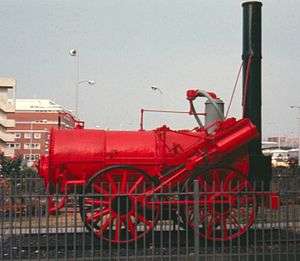Canterbury and Whitstable Railway
|
Invicta preserved at Canterbury in the 1970s | |
| Locale | Kent, England |
|---|---|
| Dates of operation | 1830–1953 |
| Track gauge | 4 ft 8 1⁄2 in (1,435 mm) |
| Length | 6 miles 0 chains (9.66 km) |
| Canterbury and | ||||||||||||||||||||||||||||||||||||||||||||||||||||||||||||||||
|---|---|---|---|---|---|---|---|---|---|---|---|---|---|---|---|---|---|---|---|---|---|---|---|---|---|---|---|---|---|---|---|---|---|---|---|---|---|---|---|---|---|---|---|---|---|---|---|---|---|---|---|---|---|---|---|---|---|---|---|---|---|---|---|---|
Legend | ||||||||||||||||||||||||||||||||||||||||||||||||||||||||||||||||
| ||||||||||||||||||||||||||||||||||||||||||||||||||||||||||||||||
The Canterbury and Whitstable Railway, sometimes referred to colloquially as the Crab and Winkle Line, was an early British railway that opened in 1830 between Canterbury and Whitstable in the county of Kent, England.
Early history
There are a number of other claimants to the title "first railway in Britain", including the Middleton Railway, the Swansea and Mumbles Railway and the Surrey Iron Railway amongst others.
Samuel Lewis in his 'A Topographical Dictionary of England' in 1848, called it the first railway in South of England.[1]
From the beginning, the 1830 Canterbury and Whitstable Railway was a public railway, intended for passengers as well as freight. Indeed, the world's first season ticket was issued for use on the line in 1834,[2] to take Canterbury passengers to the Whitstable beaches for the summer season. Unlike the Liverpool and Manchester Railway which opened four months later, it used cable haulage by stationary steam engines over much of its length, with steam locomotives restricted to the level stretch.
Until the early nineteenth century Canterbury's line of supply for goods had been along the River Stour which flows to Pegwell Bay, near Ramsgate on the eastern cost of Kent. Although this is only seventeen miles (27 km) as the crow flies, the meandering river journey is around seventy miles (110 km). The river was continually silting up, and the cost of dredging such a length was prohibitive. Although turnpikes had been built, four or five carts were needed to carry the load of a single barge.
Whitstable, on the coast about seven miles (11 km) due north, was at that time a small fishing village and port with a trade in iron pyrites from the Isle of Sheppey. The idea for the line came from William James who surveyed the route and produced plans for improving the harbour. The immediate problem was that the land between Whitstable and Canterbury rose to a height of two hundred feet (61 m), and railway haulage on steep gradients was technically very difficult at that time. The only alternative would have been a much longer route through Sturry, Herne and Swalecliffe and land acquisition would have been a major cost.
Accordingly, the direct route was chosen with three steep gradients, two of them to be worked by ropes from stationary steam engines. Leaving Canterbury, there was a steep incline to near the top of Tyler Hill, followed by an 828-yard (757 m) tunnel, then a descent through Clowes Wood to Bogshole Brook. From there the final two miles (3.2 km) were substantially level apart from a short incline down to Whitstable. The line received its Act of Parliament in 1825. Construction began in 1828 with George Stephenson as the engineer, with the assistance of John Dixon and Joseph Locke. The line cost far more than predicted and the promoters returned to Parliament three more times to obtain authorisation for the raising of additional funds. The construction of Whitstable Harbour, under the direction of Thomas Telford, was completed in 1832.
The line finally opened on 3 May 1830, with a single track throughout and passing loops at Clowes Wood and the entrance to Tyler Hill tunnel. The track consisted of fifteen-foot (4.6 m) fish-bellied iron rails on wooden sleepers at three-foot (0.91 m) intervals, the more usual alternative of stone blocks being considered too expensive. Initially Stephenson had recommended the use of stationary engines for the three inclines, with horses for the level sections. However the promoters insisted on use of a locomotive for the least difficult incline, and Invicta was procured from Robert Stephenson and Company, the twentieth they had produced, and it was brought to Whitstable by sea. Unfortunately the short gradient from Whitstable proved too much for it, and a third stationary engine was installed in 1832.
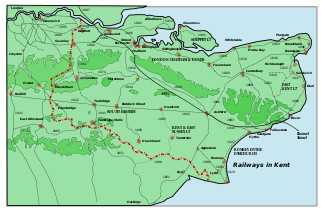
The line was visited by Isambard Kingdom Brunel in 1835. The purpose of his visit was to conduct some experiments in order to silence some of the criticism he had received in relation to his proposals for the Great Western Railway, particularly the perceived problems of working a tunnel on a steep gradient, which Brunel wished to do at Box Tunnel.[3]
Also in 1835, the Invicta was modified in order to improve its performance. The modification was unsuccessful and led to the locomotive being taken out of service, and trains being hauled only by the stationary engines. The C&WR tried to sell the Invicta in 1839 in order to clear some of its debts, but no buyers were found. The Invicta was later given to the Canterbury City Corporation and for many years stood on a plinth in the Dane John Gardens beside the Riding Gate. Invicta is currently on display at Canterbury Museum, cosmetically restored.
South Eastern Railway
The line was bedevilled by financial problems and was facing bankruptcy when the South Eastern Railway, which had received the Royal Assent in 1844, agreed to take it over, operating it in isolation from their own line. Invicta by now was virtually useless and horse traction was being used.
When the South Eastern Railway's own network eventually reached Canterbury in 1846,[4] it decided to convert the line for use with its own locomotives throughout, after upgrading the track. Under George Stephenson's influence the track had been built to standard gauge, but the loading gauge was small, the height of Tyler Hill Tunnel being only twelve feet (3.7 m) and the South Eastern locomotives were modified with shorter chimneys and lowered boilers.[5] Canterbury North Lane station closed in 1846, Canterbury West served the line after that date.[4]
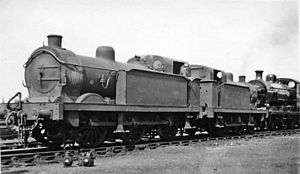
The line was never prosperous, even under South Eastern management, and there was a new setback when the London, Chatham and Dover Railway opened in 1860 offering a better passenger service from Whitstable to London. At the turn of the century work started on building a spur line at Whitstable to connect with the Herne Bay to Faversham line and a bay platform at Whitstable & Tankerton station but the work was never completed. In the early 1900s halts were built at Blean & Tyler Hill, South Street and Tankerton which brought some increased patronage.
Twentieth century operations
In 1923 the line became part of the Southern Railway and like many other lines around the country it suffered from competition from bus services. Passenger services were withdrawn on 1 January 1931. It continued to carry coal, grain and roadstone, with munitions to the harbour during World War II. By 1948, when it became part of British Railways, Whitstable Harbour had fallen into disuse and what was left of the line's trade had disappeared.
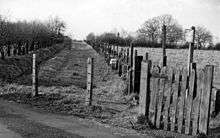
Closure and lifting
The line closed with effect from 1 December 1952, albeit with a short reprieve during the floods of February 1953, the line being reopened from 5 February to 1 March in order for traffic to bypass the main line between Whitstable and Faversham, damaged in the flood.[4] Track was lifted almost immediately and the associated infrastructure was removed.
Remains today (correct to 2011)
All traces of the Whitstable Harbour stations have been removed and the sites occupied by public toilets and a medical centre, respectively. The concrete base of the former goods shed that stood between the mid-1920s and 2009 is still visible, adjacent to the harbour with the former entrance gates still displaying the initials "SE&CR" (South Eastern & Chatham Railway). The bridges crossing Teynham Road and the mainline were removed in the 1950s, although their abutments are still in place. The famous bridge at Old Bridge Road (previously Church Road) was demolished in 1969. The track bed leading from the site of the bridge adjacent to Whitstable railway station to the site of South Street Halt was surfaced in 1983 as a designated footpath and cycle track. There is no trace of South Street Halt, although remains of the level crossing gates were visible until the early 1980s. The railway embankment can be clearly seen from the adjacent cycle route bridge as it crosses fields and is cut through by the A299 road. A bridge remains near Bogshole Brook, which dates from the line's construction, although it was almost certainly reconstructed c.1846. A section of trackbed through Clowes Wood is also a footpath where the site of the winding house can be found. The site of Blean & Tyler Hill Halt is occupied by the driveway leading to a bungalow. About half mile section of trackbed remains abandoned leading to the visible blocked up tunnel mouths of Tyler Hill Tunnel. At the south end of the tunnel the blocked up tunnel can be seen with a short section of embankment. South of Beaconsfield Road there is a short section of embankment near St. Stephen's Pathway. The arch of a buried pedestrian tunnel is visible probably built during the 1830s following a death on the line. The site of Canterbury North Lane station was a goods yard until around 1980 when it was closed. A plan was mooted in the 1980s to open a railway museum on the site, but it remained derelict until being sold for housing development and the extension of Station Road West in about 1998. The Goods Shed was restored and became the country's first 6-day farmers Market and restaurant. The original weighbridge house and a level crossing gate into the former goods yard are preserved in the development. The Invicta has been preserved, having been extensively restored in 1979, and can be seen in the Museum of Canterbury. The locomotive is not in its original form, since various modifications were made around 1836 in an effort to improve its performance. One of the stationary steam engines also survives, having been in the possession of the University of Kent and is currently (2012) undergoing restoration. Its wheel is visible in Gas Street, Canterbury. Part of the Tyler Hill tunnel collapsed at the beginning of July 1974, causing severe subsidence to some buildings at the University of Kent at Canterbury that had been built on the hill above. The resulting voids were filled over the next year, using fly-ash from Richborough power station.[6]
Restoration
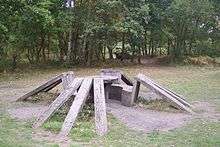
In 1997, a charity, The Crab and Winkle Line Trust,[3] was formed to reopen the route as a footpath and cycleway. In 1999, a footpath and cycleway was opened between Canterbury and Whitstable, running along part of the original trackbed. There are plans to allow public access to more of the line.
The Winding Pond, which formerly supplied water for the static winding engine which brought trains up the hill from Whitstable, was incorporated into a picnic and rest area for cyclists and walkers on the route.
References
- ↑ Lewis, Samuel (1848). "'Whitley - Whittering'". 'A Topographical Dictionary of England'. Institute of Historical Research: 555–557. Retrieved 10 March 2014.
- ↑ Searle, Muriel V. (1982). Lost Lines: An Anthology of Britain's Lost Railways. Andover, England: New Cavendish Books. p. 12. ISBN 0-904568-41-5.
- 1 2 The Crab and Winkle Line Trust
- 1 2 3 Scott-Morgan, John (2008). Branches & Byways - Kent. Hersham: Oxford Publishing Co. pp. 74–75. ISBN 978-0-86093-616-9.
- ↑ Gammell, Christopher. Southern Branch Lines. Yeovil, England: Oxford Publishing Co. p. 48. ISBN 0-86093-537-X.
- ↑ Graham Martin, From Vision to Reality: the Making of the University of Kent at Canterbury (University of Kent at Canterbury, 1990) pages 225-231 ISBN 0-904938-03-4
Bibliography
- Maxted, I. (1970). The Canterbury & Whitstable Railway. Oakwood Press. ISBN 0-7110-2934-2.
- Ratcliffe, R.L. (1980). Canterbury & Whitstable Railway 1830-1980. Locomotive Club of Great Britain. ISBN 0-905270-11-8.
- Hart, Brian (1991). The Canterbury and Whitstable Railway. Didcot: Wild Swan Publications. ISBN 0-906867-97-5.
- Page, M. In the Tracks of Railway History – A Walk along the line of the Canterbury and Whitstable Railway. ISBN 0-9515828-1-X.
- Macnair, Miles (2007). William James (1771-1837): the man who discovered George Stephenson. Oxford: Railway and Canal Historical Society. ISBN 978-0-901461-54-4.
- Oppitz, Leslie (2003). Lost Railways of Kent. countrysidebooks.co.uk. ISBN 1-85306-803-9. External link in
|publisher=(help) - Fellows, Rev. R.B. (1930). History of the Canterbury and Whitstable Railway. Canterbury: Jennings.
External links
| Wikimedia Commons has media related to Canterbury and Whitstable Railway. |
- Harbour Heights DVD production on The Canterbury & Whitstable Railway
- The Canterbury and Whitstable Railway
- The Crab & Winkle Line
- Sustrans Crab and Winkle Way
- The History Files: Railway Walks - Whitstable to Canterbury
